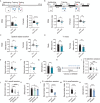Intestinal Clock Promotes Cognitive Memory Through Adenosine Signaling
- PMID: 40539410
- PMCID: PMC12442615
- DOI: 10.1002/advs.202504526
Intestinal Clock Promotes Cognitive Memory Through Adenosine Signaling
Abstract
Although the intestinal clock (the circadian timing system in the gastrointestinal tract) is known to direct a wide variety of diurnal nutrients and metabolites, its role in the functioning of extra-intestinal tissues such as the brain remains elusive. Here the role of the intestinal clock in shaping cognitive function is investigated. It is found that Bmal1-iKO mice (mice with Bmal1 [Brain and muscle Arnt-like protein 1] specifically knocked out in the intestine, a mouse line deficient in intestinal clock function) show a defect in cognitive memory irrespective of the time-of-day. Bmal1-iKO-associated cognitive decline is attributed to impaired adenosine signaling and compromised long-term potentiation (LTP) in the hippocampus. Adenosine signaling promotes LTP via enhancing BDNF expression and inhibiting synapse loss. Furthermore, the impairment in adenosine signaling is accounted for by the reductions in intestinal absorption of and hippocampal level of adenosine but not by a change in adenosine receptors. Consistently, adenosine supplementation rescues cognitive deficits associated with the malfunction of the intestinal clock. Moreover, BMAL1 regulates the expression of ADK (adenosine kinase, a primary enzyme for adenosine clearance) in the small intestine and thus promotes intestinal adenosine absorption through REV-ERBα which binds directly to Adk P2 promoter to inhibit its transcription. Together, an unsuspected role of the intestinal clock in controlling cognitive memory is identified, highlighting the intestinal clock as a promising target for the management of cognitive disorders.
Keywords: adenosine; circadian rhythm; cognitive memory; intestinal clock.
© 2025 The Author(s). Advanced Science published by Wiley‐VCH GmbH.
Conflict of interest statement
The authors declare no conflict of interest.
Figures








References
MeSH terms
Substances
Grants and funding
LinkOut - more resources
Full Text Sources
Medical
Research Materials
Miscellaneous
